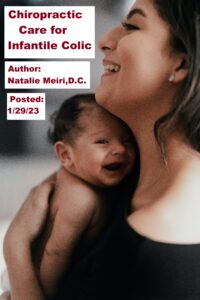
The fact is Chiropractors receive training to treat all people, from babies to the elderly. And many children have benefited from chiropractic care, including babies. Moreover, Chiropractic care is among the most common complementary and integrative health care practices used by children in the United States (US National Center for Health Statistics Report, 2015) and internationally.
So children with musculoskeletal conditions often seek chiropractic treatment. However, in the case of infants, infantile colic is one of the more common chief complaints at the chiropractic office. Furthermore, many parents have proclaimed success with colic or in getting their babies to sleep better after getting them chiropractic care.
In a 2011 study on chiropractic care for infants with colic, the authors summarized 26 articles (clinical trials, studies, case reports, literature reviews/commentaries). In conclusion, the study stated chiropractic offers a safe and effective alternative treatment approach for the child with infantile colic.

What is Infantile Colic?
Firstly, within the first few weeks after birth infantile colic is a common condition.
Secondly, your infant may cry for 3 hours a day, for more than 3 days a week, and for a minimum of 3 weeks. The recurrent episodes of prolonged and uncontrollable crying and irritability seem to be of unknown cause. And your infant is otherwise healthy.
Thirdly, one theory is the cause is probably gastrointestinal. The colic seems to occur after feeding and with an increased amount of flatulence.
Fourthly, another theory is that infantile colic is due to an immature nervous system that overreacts to normal negative or positive changes in the environment. For instance, stimuli such as hunger, gas, fatigue, music, voices and even handling could cause an overreaction. Next, this overreaction would lead to infantile colic.
Treatment of Infantile Colic
The medical management of colic is primarily with conventional drugs. However, drugs can have harmful side effects. And it appears drugs are not as effective for infantile colic.
Numerous studies from Denmark indicated that chiropractic manipulation is effective at improving or resolving infantile colic. The most recent study compared manipulation to conventional drugs as a treatment strategy. Generally, improvement in the manipulation group was a 2 1/2-hour reduction in crying time compared with a 1-hour reduction in the drug group at 1 week.
A study in the Journal of Manipulative and Physiological Therapeutics (3) crying behavior in the infants receiving chiropractic care reduced approximately 50% (1.5 hours less per day) over the 10 day period compared to the infant group not receiving chiropractic care. After 10 days, the excessively crying infants receiving chiropractic care were almost 12 times less likely to cry compared to the infants not receiving care.

Chiropractic Care for Infantile Colic
Children have the same joints that adults do, but not fully formed yet. They are still developing and adjustments get the spine back in alignment to keep the body balanced and to prevent further problems. Also, Kids joints are still more cartilaginous than truly bony, so the adjustments have to be a little bit faster but with less force. This is due to the increased flexibility within the joint and the smaller surface area targeted.
Dr. Natalie Meiri delivers fast adjustments that are low intensity (low force) and low amplitude (low displacement). She also has helped babies and kids utilizing soft tissue techniques, cranial sacral therapy, and homeopathy. She has treated babies with infantile colic, ear infections, kids with ADHD, autism, scoliosis, sports injuries and various growing problems. Contact her at 561-253-8984 for further information on Chiropractic Care for Infantile Colic or to make an appointment.
References:
- Alcantara et al. (2011) Explore
- Klougart N, Nilsson N,lacobsenJ. Infantile colic treated by chiropractors: a prospective study of 316 cases.] Manipulative Physiol The1~ 1989;12:281-288. Nilsson N. Infantile colic and chiropractic. Eur J Chiro.1985;33 : 264-265.
- Miller et al. (2012) Journal of Manipulative and Physiological Therapeutics